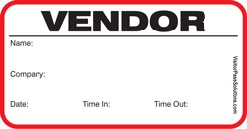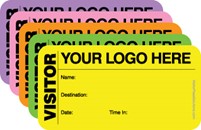Increase visitor security with the use of color: Print IN Color, Print or Write ON Color, or Stick TO Color
4/26/2021
There’s nothing like adding a little color to your visitor badges to make them stand out and help your staff quickly see, as they pass them in the hall, what kind of visitor is approaching. Does their photo match their face? Why are they here? Are they in the right place? Are they wearing a valid badge? Plus, badges that have been issued in color are harder (than plain badges) to falsify. This reinforces the legitimacy of the badges your visitors wear.
Print IN color
Many of our customers use expiring visitor badges printed on color inkjet printers. Our eVisitor Software works with Epson or Primera printers as well to create quality badges with clear, crisp photos and beautiful color logos. You decide what colors and titles work best on the visitor badges for your facility.
Color-coded visitor badges by type of visitor.
- Identifying different kinds of visitors. Vendors can be issued green badges and Volunteers can be issued orange badges (see two images above). That way, even at a glance, you know what type of visitor the person is.
- Differentiate or organize by departments (see two images below). In this scenario, each department would be given their own color and anyone with the “wrong” color badge in that department should be questioned about their presence.
Color-coded visitor badges by department.
- Color-coding visitor badges by the day of the week. Every day of the week is issued a different color – for example, Monday could be red and Tuesday blue. So, if a person tries to gain access to the facility on a Tuesday wearing a red visitor badge, it will be easy to spot and the visitor should be questioned.
- Color-coding your visitor badges by floor (if your facility has multiple floors). Each floor has its own color. This makes it easy to tell if any particular visitor is where they should be.
Print or write ON color
If you use a direct thermal printer instead of an inkjet printer for your visitor management system, there are still ways to incorporate color into your overall security plan. THRESHOLD now offers direct thermal color badges.
7 colors to choose from. Color badges provide an instant alert.
- 7 bright colors for maximum visibility
- Color code by department, type of visitor, or by days of the week
- Compatible with DYMO and Zebra direct thermal printers
- Fabric-friendly adhesive ensures the badge stays on
If you use manual sign-in books to document your visitors, there are ways to incorporate color as well. Whether you use expiring visitor badges or non-expiring visitor badges, our manual sign-in badges come with a variety of border and background colors.



Stick TO color
If you are using white visitor badges with a direct thermal printer, like DYMO, Brother, or Zebra, color coding can also be achieved using color Badge Tags. Large, colorful Badge Tags easily identify visitors from a distance. The Badge Tags can be customized just like the visitor badges above by kind of visitor, location, day of the week, or floor.


Custom and pre-printed color-coded Badge Tags by location and visitor type. Specify the location or visitor type on the Badge Tag so you know the visitor is in the right place.
Simply apply the visitor badge to the Badge Tag for maximum visibility. Badge Tags are also useful for your visitors who don’t want to apply the visitor badge directly to their clothing.
Badge Tags can be worn with a strap clip, plastic clip, or lanyard. Badge Tags work with both time-expiring badges and non-expiring badges. Some styles of Badge Tags are reusable up to six times and other styles are disposable after one use.
Contact THRESHOLD to learn more about using color to increase security
What you gain when you have an effective visitor management system (and what you risk when you don't)
next »


